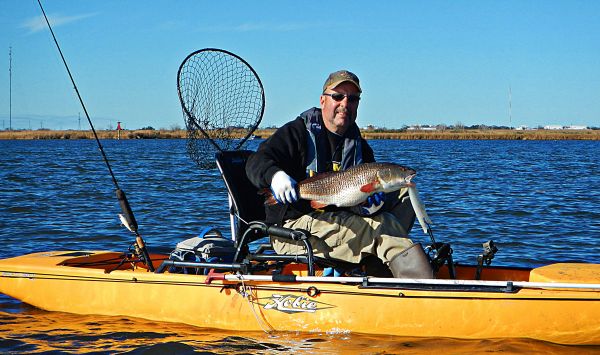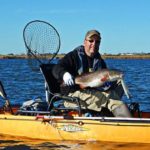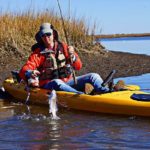
Cold fronts shouldn’t keep you home
As we get deep into winter, many kayak anglers hang up their paddle, preferring to wait until the first signs of spring make thoughts of getting back on the water more appealing.
Using this off-time to clean and organize gear and add those accessories to your kayak is not a bad idea.
However, while you’re sitting at home, you might be missing out on some of the best redfish action south Louisiana has to offer.
Redfish are much more tolerant of colder water than are speckled trout. On days when water temperatures have fallen below the 50-degree mark — when you often can’t pry a trout’s mouth open —reds will eagerly oblige. The other good news is that the reds will typically pile up in one spot and you can catch your limit plus countless others without moving an inch.
The coldest days are usually following strong cold fronts that also drain the water from the marsh. All of the small ponds you typically fish will look like a dark-chocolate moonscape. That’s the good news.
With the water gone, you now know where the fish aren’t. Use that fact and search for nearby deep canals and cuts where the fish are congregated in deeper, warmer water.
The two best areas will be deep dead-end canals and canals with sharp turns.
The dead-end canals offer stable conditions with less current. The water temperatures will remain more constant due to the lack of current. Anchor up off to one side, and work baits from the bottom and up toward the banks to find where the fish are holding. If you find a dead end that’s holding reds, there’s little doubt you will need to look any farther.
For the deep bayous with turns, the outsides of the turns will have the deepest holes caused by the current scouring this edge as it flows in and out. The reds will stack up somewhere along that turn, and you might need to reposition a time or two to locate where they prefer on that given day.
Again, work the water column to find where the fish are holding. If the area has regular boat traffic, be careful to position yourself as to not be in a blind spot to boaters coming around the bend.
Although many prefer to fish artificial lures only, there is no better bait for winter redfish than dead shrimp. The fish just can’t seem to resist a chunk of the smelly stuff when presented on a jighead or dangled at the end of a Carolina rig. Of course, if you want to bother with the live stuff, the venerable cocohoe minnow is hard to beat.
If you’re set on using artificials, the reds will hit a variety of plastic tails and slow-moving spinnerbaits and spoons. Using scented plastics like Gulp! will give you an edge to attract sluggish reds.
Winter bites can be slow and subtle. Using braided line greatly improves your chances of feeling the fish strike your bait. The rule of thumb is to set the hook at the slightest bump. More often than not it will be a fish.
Looking for a winter redfish spot? The first place to look is your favorite summer and fall spots.
Many fishermen believe redfish magically appear in the winter marsh. The truth is that they were there all along, but winter conditions tend to concentrate them.
Slot-sized redfish stay inshore and don’t generally move long distances. If an area regularly has plenty of redfish, they’re still there; you just have to locate them.
Search for the deeper spots that are close to shallow bays and ponds. The reds will move back and forth between these locations, depending on the conditions. It’s not uncommon to find them in the deep holes in the morning and then back in the ponds later in the day. Just a slight rise in water depth and temperature is often enough to scatter them back into the surrounding areas.
Shells can also play a key role in locating winter fish. Look for exposed oyster bars that extend from the shoreline out into the deeper water. The shells offer cover for all sorts of prey, and the redfish will often be there looking for a meal.
Although it’s stated ad nauseam in virtually every winter fishing article, I’m going to do it again here: “Slow your bait down.”
Work the bait as slowly as you can — and then slow it down some more. Too often you’ll find yourself working your bait at your normal retrieve speeds, but you’ll also find yourself fishless. If using dead shrimp, leaving it perfectly still on the bottom is usually all that is needed.
If you must move it, make slow, short hops along the bottom with short pauses in between.
Kayaks are also perfect for drift fishing, which is a very productive wintertime method for locating and catching reds. The slightest wind or current will slowly push the kayak down a canal or bayou.
If you have a rudder, you can steer your way through the turns and cover a long area with no need to paddle. If you don’t have a rudder, use your paddle to keep you on track.
Slowly bounce the bait off the bottom as you move along. If you catch a fish, carefully note the location where the strike occurred. Move back up to that area and see if they are concentrated there. If not, start drifting again.
Even if you don’t find the fish stacked up, you will usually pick up a few fish on each drift, and can quietly paddle back to where you started and repeat.
There’s no reason to put away your kayak just because it’s cold. Adapt your fishing techniques and locations to account for the low, cold water and you will find yourself on some hot fishing.




